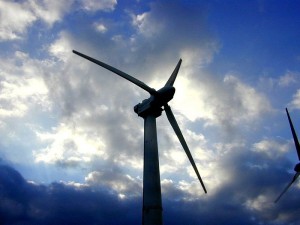
Energy is on Michigan minds.
By Brooke Kansier
As Michigan utility companies near a state deadline for generating more power from renewable sources with wide success, a new Environmental Protection Agency (EPA) standard could push the state toward clean energy at an even faster pace.
In August, the EPA announced the Clean Power Plan (CPP), a blueprint for cutting nearly a third of carbon emissions from power plants by 2030. Power plants are the nation’s biggest single contributor to carbon emissions, producing 31 percent, according to the EPA.
“The clean power plan is going to drive a major transformation in how we produce energy in the state, throughout the Midwest and really, throughout the country,” said John Austerberry, communications manager for DTE Energy Co., one of Michigan’s largest energy providers.
The CPP gives states 15 years to meet emission reduction requirements and will set goals and checkpoints to guide states along the way. It offers states two options: implement a pre-made federal blueprint to help meet CPP requirements over time, or develop and implement a plan of their own.
The details of the federal blueprint are yet to be shared with states, said Judy Palnau, press officer for the Public Service Commission’s Agency for Energy.
But Gov. Rick Snyder has already announced that Michigan will develop its own plan to comply with the CPP.
“By doing so, Michigan would be in control of its energy future, not putting itself in the hands of Washington, D.C.,” Palnau said.
And thanks to its Renewable Energy Portfolio Standard, Michigan already has a head start. Introduced in 2008, it requires utilities to get 10 percent of their energy from renewable sources by the end of this year. Nearly all utilities are on track to meet the standard.
“The 10 percent standard did a good job starting to add renewables into our energy generation mix,” Austerberry said. “The utilities have learned a lot about how these resources work, how they fit in with other types of generation and how to maximize the benefits of them in the larger system.”
DTE and Jackson-based Consumers Energy are Michigan’s largest utility companies. While DTE provides most energy to Southeast Michigan, Consumers provides electricity and natural gas to a large part of the northern Lower Peninsula, including Cheboygan, Charlevoix, Muskegon, Crawford and Ottawa counties.
While Michigan’s plan is still in early stages of development, the state has decided on a stakeholder process to determine its options. Palnau said anyone with an interest in Michigan’s energy future can participate.
“There may be people who say, we think we should be heavily emphasizing renewables, or other people who say, let’s go after efficiency — it’s cheaper not to build than to build,” she said. “People will have different ideas and we welcome all viewpoints.”
State plans must be submitted to the EPA by Sept. 6, 2016.
Michigan’s plan will likely involve investment in more renewables, said Brian Wheeler, senior public information director for Consumers Energy.
“When we say renewable, it covers a lot of different things,” he said. “Wind is the biggest for us, but there’s also solar, hydroelectric — we own and operate dams, for example ¬— and biomass — so manure, for lack of a better word.”
Consumers gets the majority of its renewable power from wind energy and has wind parks in Mason County on the west coast and Tuscola County in the Thumb.

Wind turbines. Image: Flickr, Brent Danely
“Wind is becoming more competitive in terms of cost,” Wheeler said. “But solar power — it’s about three times more expensive than wind. You get less output, less electricity generated, just because the sun doesn’t shine at night. It doesn’t always shine that much during the day.”
DTE is the same. Austerberry said the company produces 94 percent of renewables from wind. Just 2 percent comes from solar.
And as both major utilities plan to retire a number coal plants that have reached the end of their lives in the next few years, it opens them up to replacing those generators with something more efficient and more renewable, Austerberry said.
“We’re looking at a combination of increasing renewables, mostly wind, because that’s an abundant and relatively economical resource, along with natural gas-fired power plants,” he said.
One of those sources will likely be natural gas, according to Wheeler and Austerberry. While it’s not renewable, natural gas-fired plants are cleaner than those run on coal and produce fewer emissions, according to Austerberry.
“Renewables certainly have a place now, and we certainly think their place will increase,” he said. “But you need other sources as well.”
Palnau said encouraging residents to be more energy conscious and implementing programs like Michigan’s Appliance Recycling Program, which offers free removal and compensation for the disposal of old, inefficient refrigerators, may also be on the agenda.
Wheeler said utilities are on board to help develop the plan.
“What we’ve said and what we continue to say is, we’re going to work with the governor’s energy office and help develop a plan to comply with the federal regulations,” Wheeler said. “And that’s going to take a while — there’s going to be a lot to work through.”